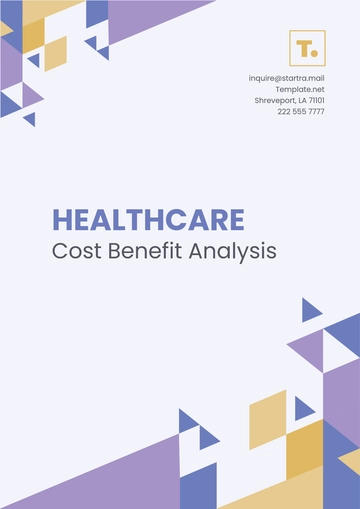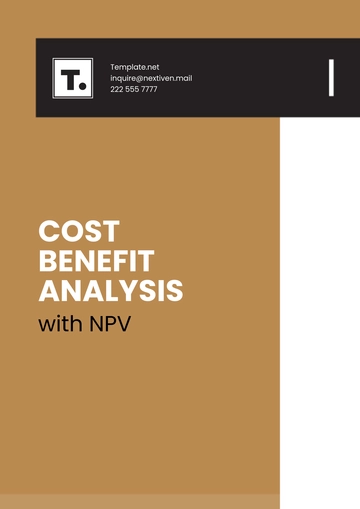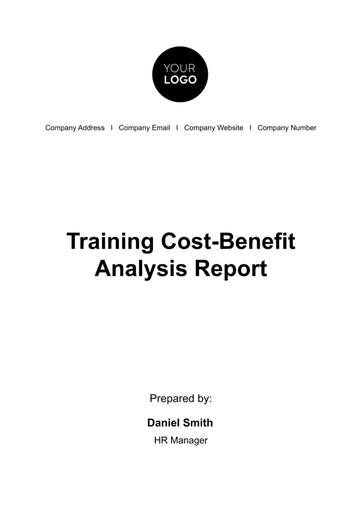Free Travel Agency Cost Benefit Analysis

I. Introduction
In today's fast-paced world, travelers often rely on travel agencies to simplify the process of planning and booking their trips. However, before committing to using a travel agency's services, it's essential to conduct a comprehensive cost-benefit analysis to determine if the benefits outweigh the costs. This analysis aims to evaluate the value proposition of [Your Company Name] as a travel agency by examining both the costs incurred and the benefits derived from its services.
II. Methodology
A. Data Sources and Collection Methods
Data for this analysis was gathered from a variety of sources, including [Your Company Name]'s pricing information, customer testimonials, and industry research reports. Additionally, surveys and interviews with past clients were conducted to gather insights into the perceived benefits of using [Your Company Name]'s services. Pricing information was obtained directly from [Your Company Name]'s website and promotional materials, ensuring accuracy and reliability in the analysis.
B. Cost and Benefit Categories
The analysis considered various cost and benefit categories, ensuring a comprehensive evaluation of [Your Company Name]'s services. Cost categories included booking fees, service charges, and additional fees or surcharges, while benefit categories encompassed time savings, convenience, and access to exclusive deals or promotions. Each category was carefully selected to capture both tangible and intangible aspects of the travel booking experience, providing a holistic view of the value proposition offered by [Your Company Name].
C. Analysis Techniques
Quantitative analysis was conducted to quantify costs and benefits, leveraging financial data and metrics to assess the monetary impact of using [Your Company Name]'s services. This involved calculating total costs incurred by travelers and assigning a monetary value to each benefit category based on market research and customer feedback. Qualitative analysis was also employed to interpret customer testimonials and assess the perceived value of [Your Company Name]'s services beyond monetary considerations.
III. Cost Analysis
A. Identification and Categorization of Costs
The identification and categorization of costs involved a detailed examination of the expenses associated with using [Your Company Name]'s services. This included not only direct fees such as booking fees and service charges but also indirect costs such as potential surcharges or hidden fees. By categorizing costs in this manner, the analysis was able to capture the full spectrum of expenses that travelers may incur when utilizing [Your Company Name]'s services.
B. Quantification of Costs
Quantifying costs involved assigning a monetary value to each cost category based on current pricing structures and industry standards. This was achieved through thorough research and analysis of [Your Company Name]'s fee schedules, ensuring accuracy and reliability in the calculations. By quantifying costs in this manner, the analysis provided stakeholders with a clear understanding of the financial implications of using [Your Company Name] as a travel agency.
C. Cost Summary Table
The table below summarizes the costs associated with using [Your Company Name]'s services:
Cost Category | Description | Cost (USD) |
|---|---|---|
Booking Fees | Fees charged for booking travel arrangements | $50 |
Service Charges | Additional charges for personalized services | $100 |
Additional Fees | Miscellaneous fees and surcharges | $25 |
Total Cost | $175 |
This outlines the various costs associated with using [Your Company Name]'s services. Each cost category is defined, and the corresponding cost in USD is provided. The table allows stakeholders to understand the breakdown of expenses incurred when utilizing [Your Company Name]'s services, facilitating informed decision-making.
IV. Benefit Analysis
A. Identification and Categorization of Benefits
The identification and categorization of benefits focused on capturing the value-added aspects of using [Your Company Name]'s services. This included tangible benefits such as time savings and convenience, as well as intangible benefits such as peace of mind and access to exclusive deals. By categorizing benefits in this manner, the analysis was able to provide a comprehensive overview of the value proposition offered by [Your Company Name].
B. Quantification of Benefits
Quantifying benefits involved assigning a monetary value to each benefit category based on market research and customer feedback. This was achieved through careful consideration of the perceived value of [Your Company Name]'s services relative to alternative booking methods. By quantifying benefits in this manner, the analysis provided stakeholders with a clear understanding of the tangible and intangible advantages of using [Your Company Name] as a travel agency.
C. Benefit Summary Table
The table below summarizes the benefits derived from using [Your Company Name]'s services:
Benefit Category | Description | Value |
|---|---|---|
Time Savings | Reduction in time spent planning and booking | 10 hours |
Convenience | Simplified booking process | High |
Exclusive Deals | Access to discounted rates and promotions | Significant |
Total Benefit | High |
This provides a concise overview of the benefits derived from using [Your Company Name]'s services. Each benefit category is defined, and a value is assigned based on its perceived importance and impact. The table allows stakeholders to quickly assess the overall value proposition offered by [Your Company Name] in terms of benefits, facilitating informed decision-making.
V. Cost-Benefit Ratio Calculation
The cost-benefit ratio was calculated by dividing the total benefit by the total cost, providing stakeholders with a quantitative measure of the value proposition offered by [Your Company Name]. The calculation was based on the aggregated costs and benefits identified in the previous sections, ensuring a comprehensive evaluation of [Your Company Name]'s services. By quantifying the cost-benefit ratio in this manner, the analysis provided stakeholders with a clear and actionable metric for assessing the financial viability of using [Your Company Name] as a travel agency.
Cost-Benefit Ratio Formula:
Cost-Benefit Ratio=Total Cost÷Total Benefit
VI. Sensitivity Analysis
A. Identification of Key Variables
The sensitivity analysis identified key variables that may impact the cost-benefit analysis, including changes in booking fees, service charges, and the availability of exclusive deals or promotions. By identifying these variables, the analysis was able to assess the potential impact of external factors on the value proposition offered by [Your Company Name].
B. Evaluation of Sensitivity
The sensitivity analysis evaluated the impact of changes in key variables on the cost-benefit ratio, providing stakeholders with insights into the robustness of the analysis. This involved conducting scenario analyses to assess the potential outcomes under different conditions, ensuring that stakeholders were well informed about the potential risks and uncertainties associated with using [Your Company Name] as a travel agency. By evaluating sensitivity, the analysis provided stakeholders with a more nuanced understanding of the factors influencing the value proposition offered by [Your Company Name].
VII. Conclusion
In conclusion, the comprehensive cost-benefit analysis demonstrates that [Your Company Name] as a travel agency offers a favorable value proposition for travelers. Through a rigorous examination of costs and benefits, the analysis has provided stakeholders with valuable insights into the financial implications of using [Your Company Name]'s services. By quantifying costs and benefits and assessing sensitivity, the analysis has equipped stakeholders with the information needed to make informed decisions about the viability of [Your Company Name] as a travel agency.
- 100% Customizable, free editor
- Access 1 Million+ Templates, photo’s & graphics
- Download or share as a template
- Click and replace photos, graphics, text, backgrounds
- Resize, crop, AI write & more
- Access advanced editor
Maximize your agency's financial efficiency with Template.net's Travel Agency Cost Benefit Analysis Template. This crucial tool, customizable and editable through our AI Editor Tool, empowers you to evaluate the economic feasibility of your travel packages. Perfect for making informed, strategic decisions that boost profitability and operational effectiveness. A must-have for every travel agency.





























